DODGE VIPER 2004 ZB / 2.G Owners Manual
Manufacturer: DODGE, Model Year: 2004, Model line: VIPER, Model: DODGE VIPER 2004 ZB / 2.GPages: 236, PDF Size: 4.18 MB
Page 151 of 236

Engine Oil Viscosity Chart
The proper SAE viscosity grade of engine oil should be
selected based on the following recommendation and be
within the operating temperature shown in the engine oil
viscosity chart.
Synthetic Engine Oils
There are a growing number of engine oils being pro-
moted as either synthetic or semi-synthetic. If you choose
to use such a product, useonlythose oils that meet the
American Petroleum Institute (API) and SAE viscosity
standard. Follow the service schedule that describes your
driving type.
Materials Added To Engine Oils
It is not necessary to add any materials to crankcase oils
for most types of vehicle operation. The addition of
materials containing antirust or antiscuff additives can be
beneficial under certain conditions. These include: infre-
quent operation, short trips, and during break-in after a
major engine overhaul. The manufacturer's Engine Oil
Supplement is recommended for these situations.
Disposing of Used Engine Oil
Care should be taken in disposing of used engine oil from
your vehicle. Used oil, indiscriminately discarded, can
MAINTAINING YOUR VEHICLE 151
7
Page 152 of 236

present a problem to the environment. Contact your
dealer, service station, or governmental agency for advice
on how and where used oil can be safely discarded in
your area.
Engine Oil Filter
The engine oil filter should be replaced with a new filter
at every engine oil change.
Engine Oil Filter Selection
All manufacturer's engines have a full-flow type dispos-
able oil filter. Use a filter of this type for replacement. The
quality of replacement filters varies considerably. Only
high quality filters should be used to assure most efficient
service. Mopartengine oil filters are high quality oil
filters and are recommended.
Drive Belts Ð Check Condition and Tension
At the mileage shown in the appropriate ªMaintenance
Scheduleº, check the condition of the drive belt for
condition and proper tension. Improper belt tension can
cause belt slippage and failure.
Inspect the drive belt for evidence of cuts, cracks, or
glazing and replace it if there is any sign of damage
which could result in belt failure.
Spark Plugs
Spark plugs must fire properly to assure proper engine
performance and emission control. Install new recom-
mended plugs with the recommended gap at the speci-
fied mileage.
Refer to the ªVehicle Emission Control Informationº label
in the engine compartment for spark plug information.
152 MAINTAINING YOUR VEHICLE
Page 153 of 236
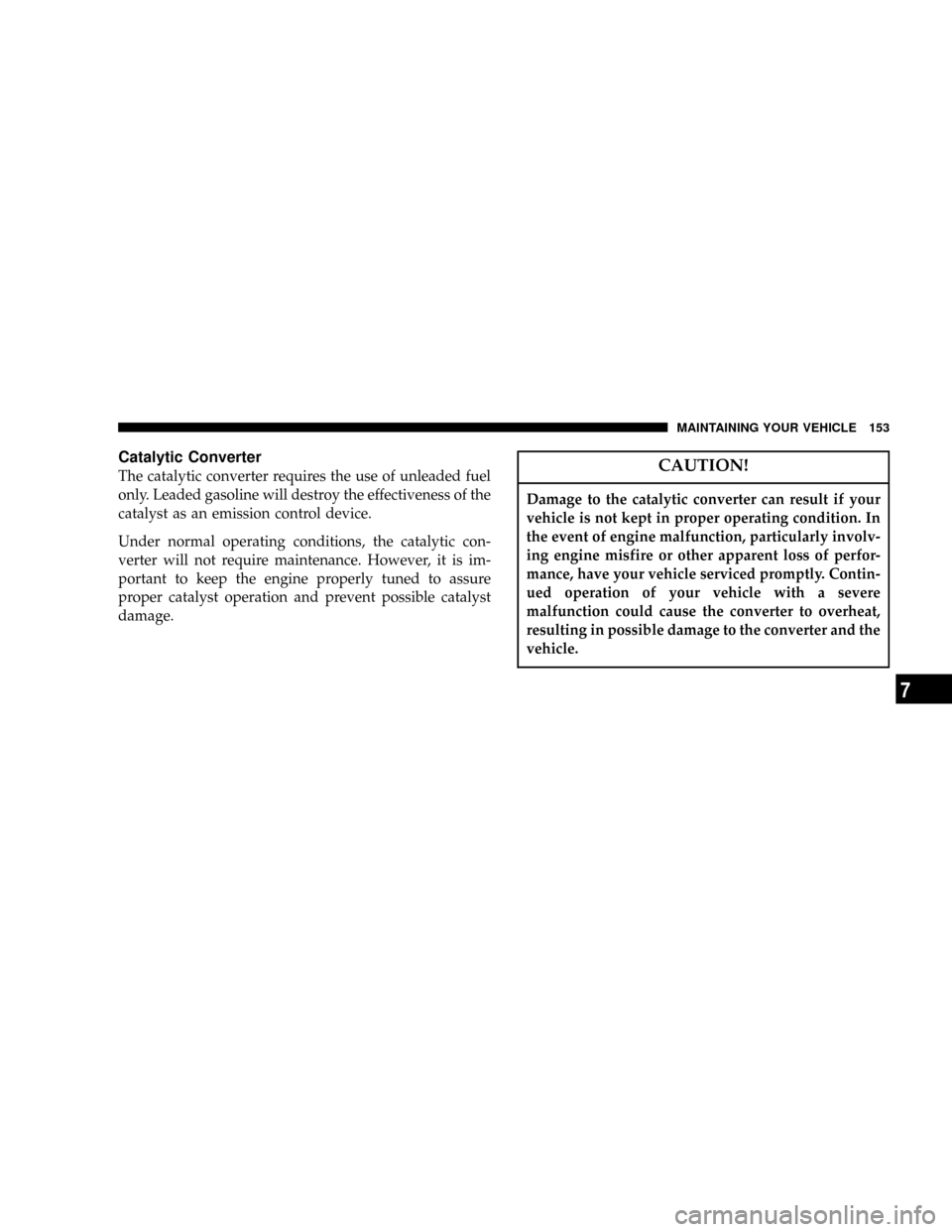
Catalytic Converter
The catalytic converter requires the use of unleaded fuel
only. Leaded gasoline will destroy the effectiveness of the
catalyst as an emission control device.
Under normal operating conditions, the catalytic con-
verter will not require maintenance. However, it is im-
portant to keep the engine properly tuned to assure
proper catalyst operation and prevent possible catalyst
damage.CAUTION!
Damage to the catalytic converter can result if your
vehicle is not kept in proper operating condition. In
the event of engine malfunction, particularly involv-
ing engine misfire or other apparent loss of perfor-
mance, have your vehicle serviced promptly. Contin-
ued operation of your vehicle with a severe
malfunction could cause the converter to overheat,
resulting in possible damage to the converter and the
vehicle.
MAINTAINING YOUR VEHICLE 153
7
Page 154 of 236

WARNING!
A hot exhaust system can start a fire if you park over
materials that can burn. Such materials might be
grass or leaves coming into contact with your ex-
haust system. Do not park or operate your vehicle in
areas where your exhaust system can contact any-
thing that can burn.
In unusual situations involving grossly malfunctioning
engine operation, a scorching odor may suggest severe
and abnormal catalyst overheating. If this occurs, stop
the vehicle, turn off the engine and allow it to cool.
Service, including a tune up to manufacturers specifica-
tions, should be obtained immediately.To minimize the possibility of catalytic converter dam-
age:
²Do not shut off the engine or interrupt the ignition
when the transmission is in gear and the vehicle is in
motion.
²Do not try to start the engine by pushing or towing the
vehicle.
²Do not idle the engine with any spark plug wires
disconnected for prolonged period.
Ignition Wiring System and Ignition Timing
The ignition cables should be kept clean and properly
connected. Terminals should be fully seated. Do not
remove the nipple assemblies from the coil towers unless
the nipples are damaged or cable testing shows high
resistance or broken insulation. Refer to the Service
154 MAINTAINING YOUR VEHICLE
Page 155 of 236
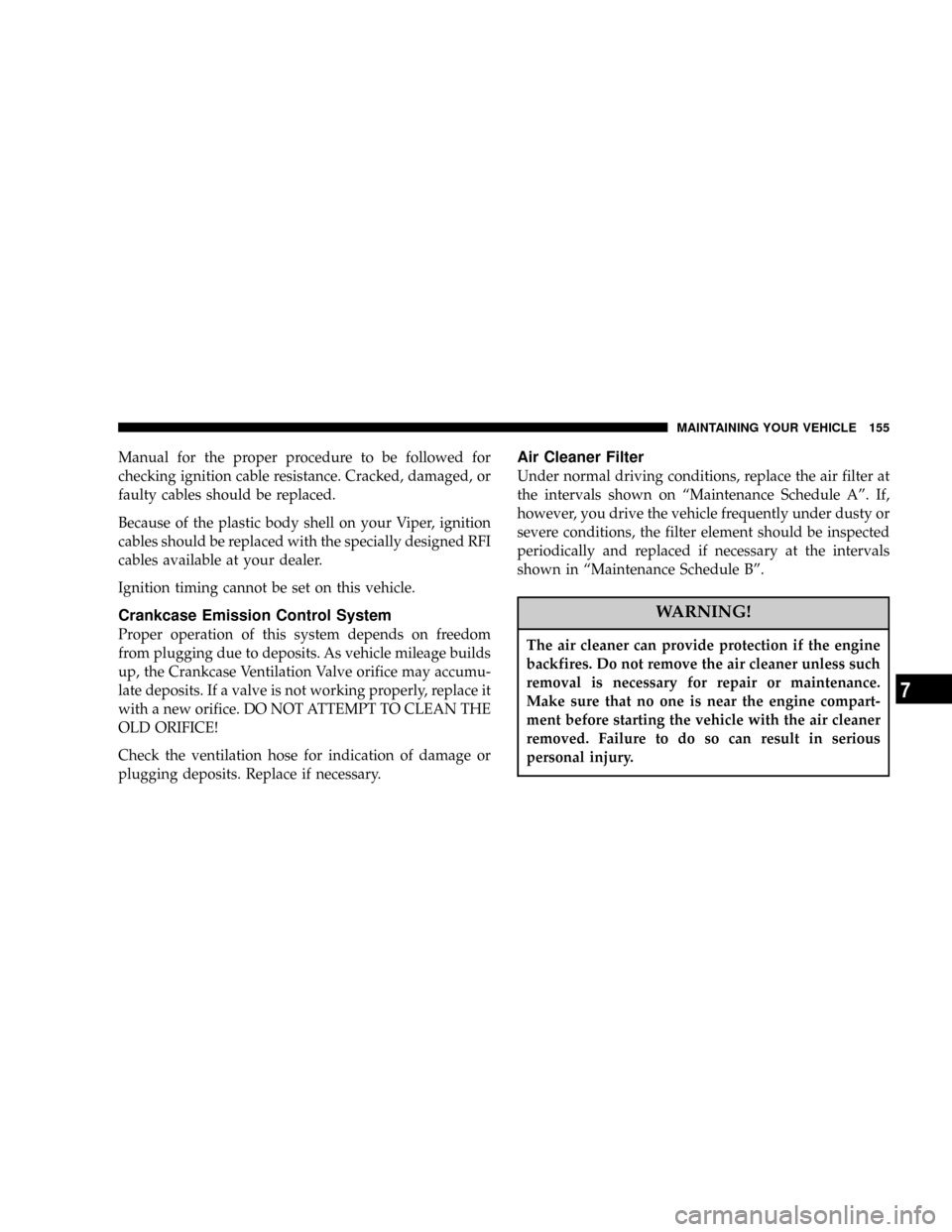
Manual for the proper procedure to be followed for
checking ignition cable resistance. Cracked, damaged, or
faulty cables should be replaced.
Because of the plastic body shell on your Viper, ignition
cables should be replaced with the specially designed RFI
cables available at your dealer.
Ignition timing cannot be set on this vehicle.
Crankcase Emission Control System
Proper operation of this system depends on freedom
from plugging due to deposits. As vehicle mileage builds
up, the Crankcase Ventilation Valve orifice may accumu-
late deposits. If a valve is not working properly, replace it
with a new orifice. DO NOT ATTEMPT TO CLEAN THE
OLD ORIFICE!
Check the ventilation hose for indication of damage or
plugging deposits. Replace if necessary.
Air Cleaner Filter
Under normal driving conditions, replace the air filter at
the intervals shown on ªMaintenance Schedule Aº. If,
however, you drive the vehicle frequently under dusty or
severe conditions, the filter element should be inspected
periodically and replaced if necessary at the intervals
shown in ªMaintenance Schedule Bº.
WARNING!
The air cleaner can provide protection if the engine
backfires. Do not remove the air cleaner unless such
removal is necessary for repair or maintenance.
Make sure that no one is near the engine compart-
ment before starting the vehicle with the air cleaner
removed. Failure to do so can result in serious
personal injury.
MAINTAINING YOUR VEHICLE 155
7
Page 156 of 236

Maintenance-Free Battery
The top of the MAINTENANCE-FREE battery is perma-
nently sealed. You will never have to add water, nor is
periodic maintenance required.
The battery is in a compartment inside the trunk on the
left side.To service the battery:
1. Locate the battery compartment inside the trunk.
2. Remove the battery cover mounting screws and re-
move the battery cover.
3. Remove the negative battery cable post and then
remove the positive battery cable post connection.
4. Remove or loosen the battery retainer clamp and bolt.
5. Lift out the battery.
6. Clean out the battery tray area, freeing area of dirt,
stones and battery acid.
7. Clean and inspect the battery terminals and replace if
parts are damaged or unusable.
8. Place the battery in the tray.
9. Tighten the battery retainer clamp and bolt down.
156 MAINTAINING YOUR VEHICLE
Page 157 of 236
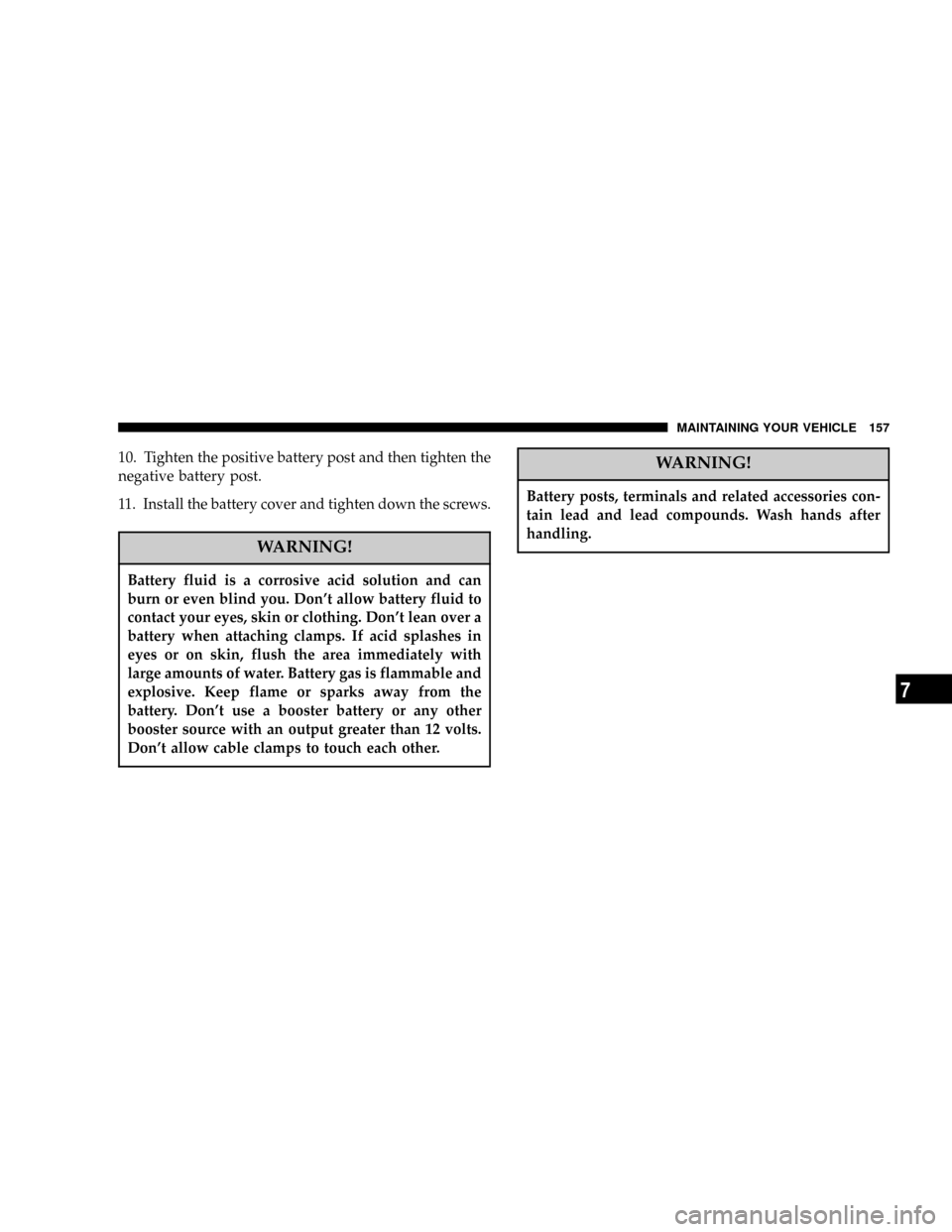
10. Tighten the positive battery post and then tighten the
negative battery post.
11. Install the battery cover and tighten down the screws.
WARNING!
Battery fluid is a corrosive acid solution and can
burn or even blind you. Don't allow battery fluid to
contact your eyes, skin or clothing. Don't lean over a
battery when attaching clamps. If acid splashes in
eyes or on skin, flush the area immediately with
large amounts of water. Battery gas is flammable and
explosive. Keep flame or sparks away from the
battery. Don't use a booster battery or any other
booster source with an output greater than 12 volts.
Don't allow cable clamps to touch each other.
WARNING!
Battery posts, terminals and related accessories con-
tain lead and lead compounds. Wash hands after
handling.
MAINTAINING YOUR VEHICLE 157
7
Page 158 of 236
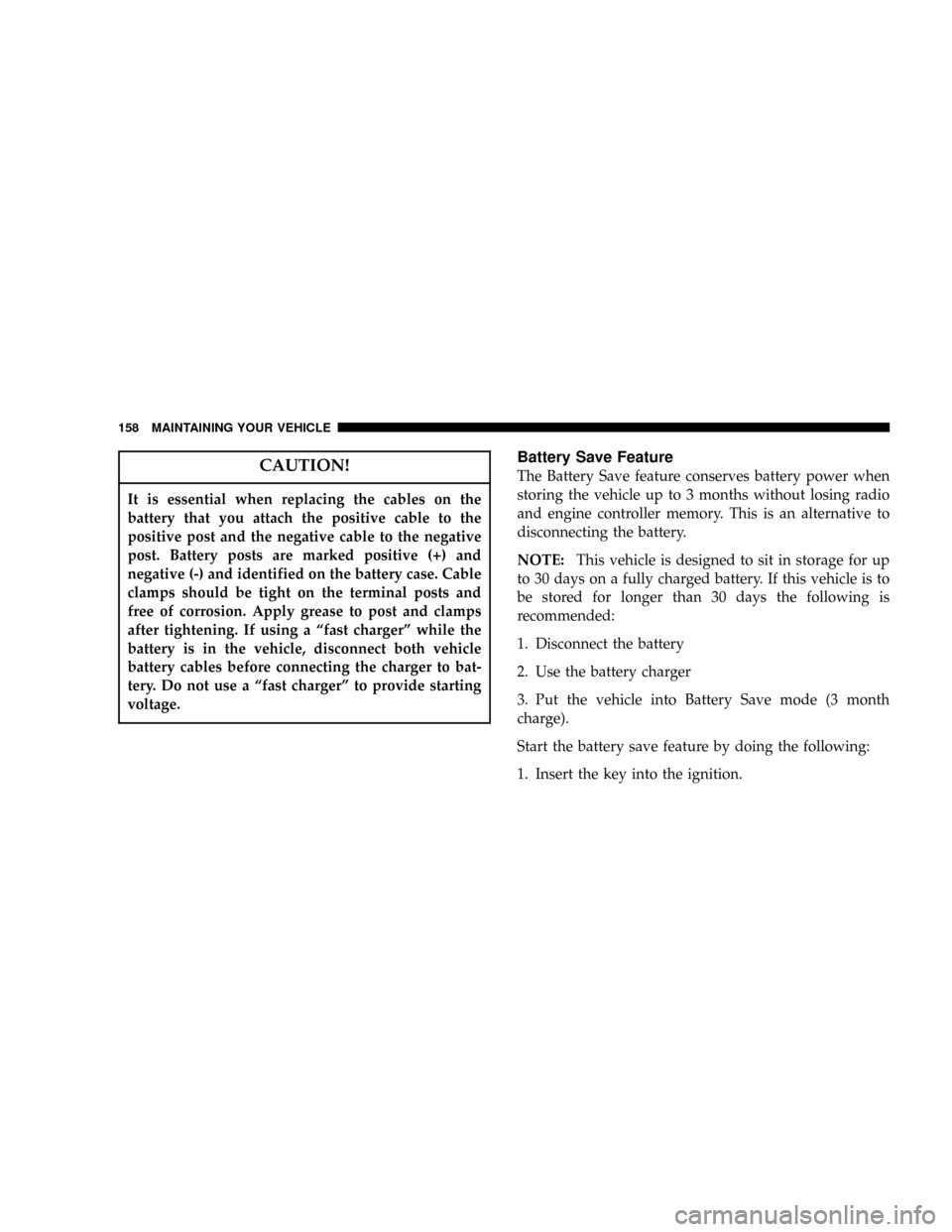
CAUTION!
It is essential when replacing the cables on the
battery that you attach the positive cable to the
positive post and the negative cable to the negative
post. Battery posts are marked positive (+) and
negative (-) and identified on the battery case. Cable
clamps should be tight on the terminal posts and
free of corrosion. Apply grease to post and clamps
after tightening. If using a ªfast chargerº while the
battery is in the vehicle, disconnect both vehicle
battery cables before connecting the charger to bat-
tery. Do not use a ªfast chargerº to provide starting
voltage.
Battery Save Feature
The Battery Save feature conserves battery power when
storing the vehicle up to 3 months without losing radio
and engine controller memory. This is an alternative to
disconnecting the battery.
NOTE:This vehicle is designed to sit in storage for up
to 30 days on a fully charged battery. If this vehicle is to
be stored for longer than 30 days the following is
recommended:
1. Disconnect the battery
2. Use the battery charger
3. Put the vehicle into Battery Save mode (3 month
charge).
Start the battery save feature by doing the following:
1. Insert the key into the ignition.
158 MAINTAINING YOUR VEHICLE
Page 159 of 236

2. Cycle the ignition from OFF to ACC four times with-
out going into ON. Leave the switch in the OFF position
after the fourth cycle.
3. Depress the driver's side Power Door Lock switch in
the UP direction. A single chime and a horn chirp indicate
that the process has begun.
4. Remove the key from the ignition and exit the vehicle.5. The feature is cancelled when the ignition is cycled to
ON/RUN.
6. The vehicle will enter Battery Save Mode 45 seconds
after all doors are closed.
NOTE:The remote keyless entry and passenger exterior
door handle will not work when the Battery Save feature
is enabled. Enter the vehicle either by using the key to
open the door manually or by using the outside door
handle.
NOTE:The Vehicle Theft Alarm is disabled when the
vehicle is in Battery Save mode. Therefore, the vehicle is
not protected when the Battery Save feature is enabled.
NOTE:The exterior and interior lighting functions will
not work when the vehicle is in Battery Save Mode.
Exit Battery Save Mode by doing the following:
MAINTAINING YOUR VEHICLE 159
7
Page 160 of 236
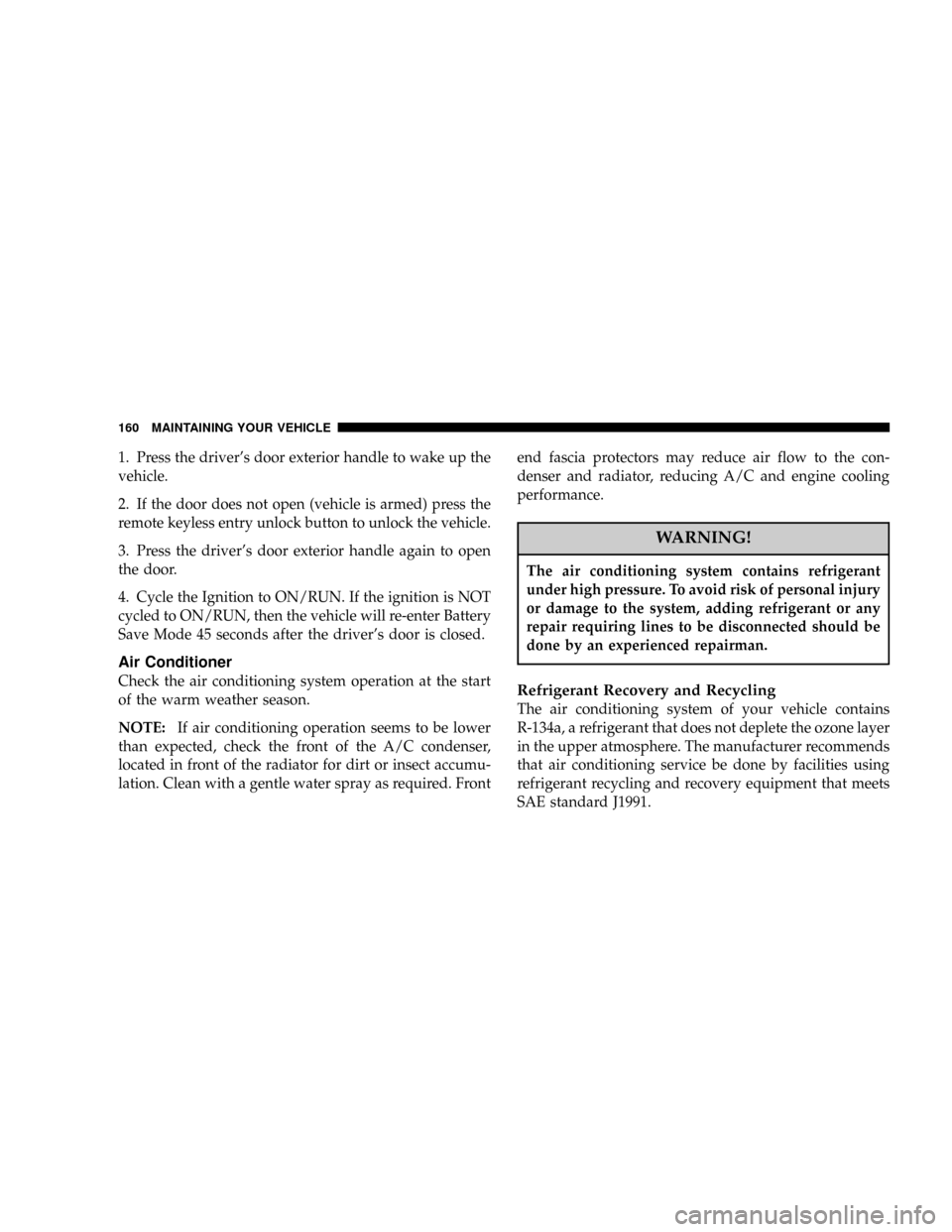
1. Press the driver's door exterior handle to wake up the
vehicle.
2. If the door does not open (vehicle is armed) press the
remote keyless entry unlock button to unlock the vehicle.
3. Press the driver's door exterior handle again to open
the door.
4. Cycle the Ignition to ON/RUN. If the ignition is NOT
cycled to ON/RUN, then the vehicle will re-enter Battery
Save Mode 45 seconds after the driver's door is closed.
Air Conditioner
Check the air conditioning system operation at the start
of the warm weather season.
NOTE:If air conditioning operation seems to be lower
than expected, check the front of the A/C condenser,
located in front of the radiator for dirt or insect accumu-
lation. Clean with a gentle water spray as required. Frontend fascia protectors may reduce air flow to the con-
denser and radiator, reducing A/C and engine cooling
performance.
WARNING!
The air conditioning system contains refrigerant
under high pressure. To avoid risk of personal injury
or damage to the system, adding refrigerant or any
repair requiring lines to be disconnected should be
done by an experienced repairman.
Refrigerant Recovery and Recycling
The air conditioning system of your vehicle contains
R-134a, a refrigerant that does not deplete the ozone layer
in the upper atmosphere. The manufacturer recommends
that air conditioning service be done by facilities using
refrigerant recycling and recovery equipment that meets
SAE standard J1991.
160 MAINTAINING YOUR VEHICLE